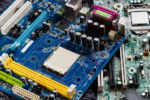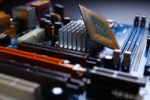Best Motherboard for Ryzen 5 5600x: Complete Reviews With Comparisons

AMD released the Ryzen 5 5600x processor late in 2020. And to this day, it still stands as one of the best processors for gaming.
Pairing this processor with the best motherboards for Ryzen 5 5600x ensures you get the best gaming experience.
The following list showcases five exceptional motherboards from the top four manufacturers in the industry.
Comparison Chart
Motherboard for Ryzen 5 5600x Reviews
1. ASUS TUF Gaming X570-Plus Wi-Fi
The ASUS TUF Gaming X570-Plus Wi-Fi is an ATX motherboard with a jet-black PCB and white and yellow accents.
It sits at a relatively low price point for its feature set. Plus, it carries some of the latest motherboard technologies.
Review
The TUF Gaming X570-Plus Wi-Fi is one of the most affordable motherboards using the X570 chipset.
It works well with the Ryzen 5 5600x processor, and it even sports some overclocking capabilities.
As far as looks go, this board carries the signature appearance of the most recent TUF Gaming motherboards.
ALSO READ: Best Motherboard for Ryzen 7 2700x
- Memory Allocations
Base memory speeds can go as high as 2933MHz, and the maximum recorded overclocking rates have reached 5100MHz.
This motherboard has four DDR4 DIMM memory slots capable of supporting up to 128GB of system RAM.
- Storage Options
The TUF Gaming X570-Plus Wi-Fi boasts eight SATA 6Gbps ports supporting RAID 0, 1, and 10.
Moreover, it has two M.2 slots that support PCIe 4.0 and SATA devices, as well as one M.2 slot for PCIe 3.0 and SATA devices.
- Expansion Capabilities
For expansion, you will find two full-sized PCIe sockets and two more with x1 lanes.
The first x16 socket supports PCIe 4.0 devices, while the second can only connect a PCIe 3.0 device.
The board can support two graphics cards using the AMD CrossFireX Technology.
However, using both full-sized expansion sockets will disable the two x1 slots.
- Rear Panel I/O
Looking at the rear input and output panel, you will find two display connectors: one HDMI and one DisplayPort.
It also has five audio jacks and an optical S/PDIF out port.
For peripherals, the rear panel has a PS/2 combo port, four USB 3.2 Gen1 ports, and three USB 3.2 Gen2 ports.
One of the USB 3.2 Gen2 ports is a Type-C.
Network connectors include one RJ45 LAN port and a dual-band Wi-Fi module.
- Internal Connectors
The TUF Gaming X570-Plus Wi-Fi can improve lighting aesthetics with its two Aura RGB strip headers and single addressable Gen2 header.
Additionally, internal headers allow up to six cooling components, including one CPU fan, one CPU OPT fan, three cassis fans, and one AIO pump.
You can also have six more USB ports through internal connections.
PROS
CONS
2. MSI MAG X570S Tomahawk Max Wi-Fi
MSI only released its X570S Series lineup early in July of this year, and the MAG X570S Tomahawk Max Wi-Fi is one of them.
Like the first motherboard, it is also an ATX form factor motherboard with a black PCB and some white and gray stripes.
The area around the chipset heatsinks has RGB lighting.
Review
The Series brings some upgrades to the previous X570 chipset motherboards from MSI.
For the MAG X570S Tomahawk Max, the major changes include a passively cooled chipset, heavily plated heatsinks, and the latest Wi-Fi 6E spec.
Other than that, everything else is pretty much the same as its predecessor.
This motherboard is another good pairing for the Ryzen 5 5600x CPU. However, it is the most expensive board among our options.
- Memory Allocations
The MAG X570S Tomahawk Max has four DDR4 memory slots with a maximum RAM capacity of 128GB.
While maximum overclocking speeds can also reach 5100MHz, this board has a base clock speed of 3200MHz.
- Storage Options
For storage, this motherboard has six SATA 6Gbps ports and two M.2 sockets.
Both M.2 sockets support SATA storage devices, but only the first socket allows PCIe 4.0 devices.
Nevertheless, you can still use a PCIe 3.0 device on the second M.2 slot.
- Expansion Capabilities
With the Ryzen 5 5600x, you can use PCIe 4.0 devices on the two x16 expansion sockets.
This feature gives you the freedom to use the latest GPUs with multi-graphics AMD CrossFire Technology.
The board also has two PCIe 3.0 x1 slots for smaller expansion cards.
- Rear Panel I/O
The rear panel only has a single HDMI port for display connectivity.
Even so, that won’t be a problem because most GPUs have built-in display connectors.
Like the TUF Gaming X570-Plus, the MAG X570S Tomahawk Max has five audio jacks and an optical S/PDIF out port.
Network connectivity features include the lone RJ45 LAN port and two Wi-Fi antenna connectors.
The board has two USB 3.2 Gen1 ports, four USB 3.2 Gen2 ports, two USB 2.0 ports, and a PS/2 combo port for peripheral devices.
One of the USB 3.2 Gen2 ports is a Type-C.
We don’t like that the rear panel still has two USB 2.0 ports, even if the board is one of the latest models.
On the contrary, we appreciate that the rear panel has a Flash BIOS button.
- Internal Connectors
If you need more USB connectors, internal connections allow four USB 3.2 Gen1, four USB 2.0, and one USB 3.2 Gen2.
The board’s cooling connectors include a CPU fan header, a water pump header, and four system fan connectors.
Additionally, this board does not hold back on RGB lighting connectors. You will find two RGB headers and two RAINBOW LED connectors.
PROS
CONS
3. Gigabyte B550 Aorus Pro AC
If you want to take advantage of the Ryzen 5 5600x without the extra features of an X570, the B550 chipset is a perfect choice.
We chose the Gigabyte B550 Aorus Pro AC because of its reliable power phasing VRMs.
Like the first two options, it has an ATX form factor with a black PCB.
Extra design features include some orange LEDs reminiscent of the Aorus lineup and massive VRM and PCH heatsinks.
Review
The B550 Aorus Pro AC offers exceptional overclocking with the Ryzen 5 5600x processor.
Unlike the TUF Gaming X570-Plus, however, it is a tad pricey for its feature set.
Its solid VRMs with aluminum fins allow better cooling than other competitors.
What’s more, it offers support for the latest PCIe 4.0 devices.
- Memory Allocations
This motherboard can overclock memory speeds up to 5400MHz.
Even better, you’ll find that overclocking is more straightforward than the other alternatives.
Additionally, it offers a maximum base clock speed of 3200MHz, much higher than the similarly-priced TUF Gaming X570-Plus.
The board has a total RAM capacity of 128GB using its four DDR4 DIMM sockets.
- Storage Options
The storage interface allows six SATA 6Gbps devices and two M.2 connections.
You can use the first M.2 slot for a PCIe 4.0 or SATA storage device and the second M.2 for PCIe 3.0 modules.
- Expansion Capabilities
Three x16 expansion sockets allow the use of multiple graphics cards.
You can use PCIe 4.0 devices on the first x16 socket, but the other two x16 slots only support PCIe 3.0 devices.
Aside from the three x16 sockets, the board also has two PCIe x1 slots.
- Rear Panel I/O
Rear I/O ports include an HDMI for display, five audio jacks, and an optical S/PDIF out port.
For network connectors, you’ll have one RJ45 LAN port and two SMA antenna connectors.
You can connect your peripheral devices using three USB 3.2 Gen1 ports, three USB 3.2 Gen2 ports, and six USB 2.0 ports.
The board doesn’t have a legacy PS/2 port, and it still uses many USB 2.0 ports.
Lastly, Gigabyte also equips this board with its signature Q-Flash Plus button.
- Internal Connectors
We like that the B550 Aorus Pro AC has eight cooling headers, which make overclocking much more manageable.
These headers include outlets for a CPU fan, a water cooler, four system fans, and two pumps or extra water coolers.
Like the MAG X570S Tomahawk Max, the B550 Aorus Pro AC has four LED strip headers, two of which allow addressable connections.
PROS
CONS
4. ASUS ROG Strix X570-I Gaming
If you want to build a smaller PC, you might want to use small form factor motherboards, such as the ASUS ROG Strix X570-I Gaming.
It has a mini ITX form factor, and it uses the same advanced X570 chipset as most of our alternatives.
Moreover, the board carries prominent ROG design features, including some LED backlighting.
Review
The ROG Strix X570-I Gaming is a premium mini-ITX motherboard with an elaborate thermal solution and a network of interconnected heatsinks.
Despite the lack of space, two 30mm fans actively cool the heatsinks, and 10 VRM phases power a Ryzen 5 5600x.
- Memory Allocations
The space constraints only allow two DDR4 DIMM sockets with a total capacity of 64GB.
Base memory clocks can go as fast as 2666MHz, but overclocking can reach speeds of 4800MHz.
- Storage Options
The ROG Strix X570-I Gaming only has four SATA 6Gbps connectors and two M.2 slots.
While both M.2 slots support SATA devices, only the first M.2 slot works with PCIe 4.0 storage drives.
As such, you will have to use a PCIe 3.0 in place of a SATA drive in the second M.2 slot.
- Expansion Capabilities
Another disadvantage of the small form factor is the single full-sized expansion slot and the lack of x1 expansion sockets.
Because of this, it does not support any multi-graphics technologies. Fortunately, the lone x16 socket can support PCIe 4.0 connections.
- Rear Panel I/O
Unlike the ATX alternatives, the rear panel on the ROG Strix X570-I Gaming has two display connectors: one DisplayPort and one HDMI.
However, for audio, the board doesn’t have an optical S/PDIF out port. Instead, it only has three audio jacks.
Other than that, you can enjoy fast network connections using the Intel Gigabit LAN port and the dual-band Wi-Fi 6 antenna connectors.
We like that this board does away without USB 2.0 ports and increases the number of high-speed USBs.
It has four USB 3.2 Gen1 ports and four USB 3.2 Gen2 ports; one of the Gen2 ports is a Type-C.
- Internal Connectors
Four more USB ports are available through the internal headers.
The board has five cooling headers to complement the comprehensive VRMs.
These headers allow an HS fan, a chassis fan, a PCH fan, a CPU fan, and a water pump.
Additionally, the board has two connectors for one Aura RGB strip and one addressable Gen2 lighting.
PROS
CONS
5. ASRock B550 Taichi
ASRock does not compete much with the number of models released by other brands. Still, it has motherboards that compete in performance.
The ASRock B550 Taichi is another ATX motherboard that doesn’t have the extraneous features of X570-based platforms.
Following the usual Taichi design scheme, it features a black PCB with steel gray heatsinks and gold PCH gears.
Review
The B550 Taichi is a very attractive motherboard with an excellent build quality and a feature-packed specs sheet.
All in all, it is a bit more expensive than some alternatives, but it is still reasonably priced.
The only thing we find a bit problematic is the overclocking, which can benefit from better BIOS UEFI.
Nevertheless, this board can help you get the most out of a Ryzen 5 5600x.
RELATED:
Motherboard for Ryzen 5 3600x (Guide)
- Memory Allocations
Like the other ATX motherboards, the B550 Taichi has four DDR4 DIMM slots capable of holding 128GB of system RAM.
Base memory speeds can run as fast as 3200MHz, but overclocking can give you RAM speeds of 5200MHz.
- Storage Options
The B550 Taichi allows up to eight SATA 6Gbps storage drives and two M.2 drive connections.
You can use a PCIe 4.0 device on the first M.2 slot.
If you want to use a PCIe 3.0 or SATA device with an M.2 connection, use the second M.2 slot.
- Expansion Capabilities
For expansion, the board has three full-sized PCIe 4.0 sockets and two PCIe 3.0 x1 slots.
Using either of the x1 slots downgrades the third full-sized socket to x2 lanes.
- Rear Panel I/O
The rear display output connectors include a DisplayPort and an HDMI port.
Audio connectors are also at maximum, with five audio jacks and an optical S/PDIF out port.
Network ports include a GigaLAN Intel I225V module and two Wi-Fi antenna connectors.
Also, the board has four USB 3.2 Gen1 ports, two USB 2.0 ports, and two USB 3.2 Gen2 ports for your peripheral devices.
Extra rear panel features include a Clear CMOS button and a BIOS Flashback button.
- Internal Connectors
If you want additional USBs, you can use internal headers to assemble eight more USBs.
Additionally, the board has seven connectors for cooling devices and four headers for RGB lighting.
PROS
CONS
Final Verdict
We recommend the ASRock B550 Taichi as the top motherboard for Ryzen 5 5600x among the options here.
It may be a bit more expensive than some alternatives, but its feature set more than makes up for the price.
Not only will you have high-end features on your motherboard, but you will also be able to get the most out of your Ryzen 5 5600x.














